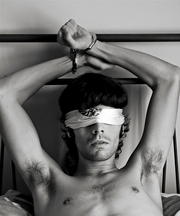Bondage (sexual)

Bondage is the use of restraints for the sexual pleasure of the parties involved. It may be used in its own right, as in the case of rope bondage and breast bondage, or as part of sexual activity or BDSM activity. When a person is sexually aroused by bondage, it may be considered a paraphilia, known as vincilagnia (from Latin vincio, to bind or fetter with chains, and lagneia, lust).
Contents |
Private bondage

Some couples do incorporate elements of bondage into their otherwise conventional sex lives at some point in their relationships. Bedroom bondage games often constitute foreplay. Bedroom bondage is usually mild bondage, with one partner voluntarily being put into restraints by being tied up or cuffed, hogtied or spread-eagled, possibly blindfolded and gagged etc. by the other, who then sexually stimulates the tied partner theoretically at will by masturbation, oral sex, a vibrator or intercourse.
Bondage can be used for purposes other than sexual foreplay. For example, it may be used in erotic tickling or for sexual teasing.
The tied partner's satisfaction is often indicated by writhing, struggling or vocalizations etc. The free partner may derive erotic pleasure or achieve sexual arousal from being in a dominant situation, while the tied partner may achieve arousal from being in a largely "helpless" position in the hands of a trusted partner. Either way, the partners may be playing out the bondage games to act out their sexual fantasies (not necessarily the same one) and many established couples find the experience relationship-affirming, as they both require and imply a level of trust between them that is not normally found within more casual relationships, as well as being a shared facet of their private and personal sex lives.
This form of bondage has its own niche on some internet websites, where images and movies usually depict voluntarily-tied models undergoing inescapable intense sexual pleasure, rather than any menace, force or pain.
Safety rules followed by couples are frequently oral or visual context- and trust-based as the tied partner may be held in a submissive sexual position. Sex therefore takes place with their pre-given consent as e.g. a sex game or rape fantasy enactment. In contrast, e.g. a photograph not agreed upon taken while the restrained person is incapable of resisting can be considered non-consensual.
The use of bondage by couples in their homes tends to be different from that associated with bondage in (for example) a BDSM dungeon, where bondage may be an end in itself with no sexual contact at all and is often combined with infliction of pain.
Bondage erotica

Some people regard bondage to be erotically stimulating or sexually arousing. Bondage features in some sexual fantasy scenarios. Studies of men's fantasies have shown that the fantasy of being bound during intercourse is second in frequency only to the basic fantasy of sex with a voluptuous nude woman. Bondage themes have been present in erotica and pornography for some time.
Bondage pornography for heterosexual men almost overwhelmingly depicts bound women, rather than bound men, despite one of the most common fantasies in both sexes being one of being bound.
Bondage fantasies often involve dressing in a role outfit. Typical outfits for the submissive person invoke common icons of passivity or sexual innocence (e.g. a shepherdess, nun or schoolgirl outfit for women, or a leather slave harness and cuffs for men). In a similar respect, the dominant person's attire often reflect images of power, control, and extreme discipline (a Nazi officer, police or prison warden uniform).
In art and popular culture
Bondage is also presented in erotic and mainstream literary forms, including cartoons and magazines, and depicted in erotic art, such as some of the works of Gustave Doré and John Everett Millais. The mythical Andromeda was a popular subject for bondage in art by painters including Rembrandt's Andromeda Chained to the Rocks (1630), Théodore Chassériau (1840), Edward Poynter (1869) and Gustave Doré (1869).
Other popular scenarios for bondage in art was that of Angelica from the fifteenth century epic poem Orlando Innamorato, which is itself a continuation of the romantic epic saga Orlando Furioso, which is similar to that of Andromeda in that the heroine is offered as a sacrifice to the sea gods; and the damsel in distress theme. The damsel in distress theme was also used in The Perils of Pauline (1914) motion picture serial, which found Pearl White in mortal danger on a weekly basis.
Depictions of bondage in art may be erotic, in which case they would tend to depict a young woman in danger and fear, and some are BDSM in style. Bizarre was a fetish and bondage magazine published between 1946-1959 by bondage artist John Willie. It included drawings and photographs using professional bondage models in bondage or sadomasochistic scenes. Sweet Gwendoline was the main female character in his works, published largely in the 1950s and 60's, and possibly the most famous bondage icon after Bettie Page. She was repeatedly depicted as the stereotypical naïve blonde damsel in distress.
Bondage received a positive (if brief) treatment in The Joy of Sex, a mainstream sex manual popular in the 1970s. The publication of Madonna's book, Sex, which included photographs of bound nudes, did a great deal to improve public awareness and acceptance of bondage.
By the 1990s, references to bondage could be found in mainstream prime-time television series such as Buffy the Vampire Slayer, where equipment such as handcuffs or collars and concepts such as the safeword were included as a matter of course.
The Claiming of Sleeping Beauty was an erotic trilogy published in the 1980s by Anne Rice under the pseudonym of A. N. Roquelaure which contained bondage scenarios, as part of a wide range of BDSM acts.
Other examples of bondage erotica include Pauline Réage's Story of O, Frank E. Campbell's books[1] and the artwork of Robert Bishop.
Recent changes:
- Steady growth in quantity and production values of niche producers
- Increasing prevalence and acceptance of bondage in more mainstream publications (e.g. Penthouse "Iris Oifigiuil")
- The rise of the Internet as a distribution medium.
 Rembrandt, Andromeda Chained to the Rocks (1630) |
 Ruggiero Rescuing Angelica, Jean Auguste Dominique Ingres (1819), based on Orlando Furioso |
 Andromeda by Gustave Doré (c.1869) |
 Théodore Chassériau: Andromeda chained to the Rock by the Nereids (1840) |
 John Everett Millais' Knight Errant of 1870 saves a Damsel in distress |
 Dresseuses d'hommes (1931) by Florence Fulbert |
 Jo-Jo comics (1948) |
 Bettie Page tied and spanked in an image from Bizarre |
BDSM


Bondage features prominently in BDSM scenes and sexual roleplay. Bondage has a sexual appeal to people of both sexes and all sexual orientations, in either a dominant (top) or submissive (bottom) role.
There are also some common fantasy settings in which bondage may be a component. These include:
- Rape, ravishment and/or abduction: The top fictitiously seizes or abducts the consenting bottom and has complete control to do what he/she pleases.
- Dominance/slavery: A training session occurs in which rewards for obedience and punishment for defiance are given. Humiliation is usually involved.
- Predicament bondage: The bottom is given a choice between two tortures. For example, caning on the rear or flogging on the chest. If the bottom cannot stand one any longer, the top will start the other. This can also be done mechanically, like having a bottom squat and rigging a crotch rope to tighten if they attempt to stand.
Bondage is often combined with other sexual and BDSM techniques.
Self-bondage is more complex, and may involve special techniques to apply bondage to oneself, and also to effect a release after a lapsed period of time. Self-bondage is also notably risky: see the safety notes below.
A large variety of bondage equipment is available for use in BDSM scenes for a number of results. These include rope, straps, or harnesses which can be used to hold limbs together; spreader bars, x-frames which can be used to keep limbs apart; the body or limbs can be tied to an object, such as to chairs or stocks; the body may be suspended from another object, as in suspension bondage; or it may used to restrict normal movement, such as use of hobble skirts, handcuffs, or pony harness. Bondage may also be used to wrap the whole body or a part of it in bindings, such as cloth or plastic (saran wrap or cling film "mummification") as well as sleepsack bondage.
One of the purposes of bondage in BDSM is to restrain a person (typically called the bottom) in a BDSM position. This may involve simply tying the hands together in front or behind. Other positions involve the use of a waist belt to anchor the hands to the front, back or sides. Other popular positions are the spread eagle, with the limbs splayed out and fastened by wrists and ankles to bedposts, door frame or some other anchoring point; the hogtie, which secures each wrist to its corresponding ankle behind the back (wider, padded restraints such as bondage cuffs are recommended for this); the balltie, which secures wrists to ankles, in front, with the knees drawn up to the chest; the crotch rope, which involves pulling a rope between the labia to apply pressure to the female genitals. Sometimes a knot is placed in the rope at the position of the clitoris to intensify the sensation. Other positions include the reverse prayer position (not recommended unless the subject has flexible shoulders), and an over-arm tie, in which the arms are brought over the head, and the wrists fastened together behind the head and then by a length of rope, chain or strapping to a belt at the waist.
The types of restraints used in bondage include rope, which is often preferred because of its flexibility. Rigging, however, requires considerable skill and practice to do safely. Other types of restraints include chains, handcuffs, thumbcuffs and belly chains. Institutional restraints, such as straitjackets may be used in some roleplays, and purpose-made bondage gear, such as monogloves, sleepsacks, bondage hooks and bondage tables, are also available.
Some BDSM play parties offer "bondage workshops", where couples, or people otherwise consenting with each other, can practice tying up each other under the instruction and supervision of an experienced bondage rigger.
Public bondage


A subculture of gay men, sometimes called leathermen, were arguably among the first group to make obvious hints of their tastes in bondage in public.
The growth of the gay leather subculture parallels the biker culture that arose after World War II -- a number of early leathermen were WWII veterans, and the military traditions of discipline and structure were an important influence in Old Guard leather. While the bikers were not identified as homosexual, the leathermen admired their toughness, tenacity, and willingness to ignore mainstream social mores. Consequently, they adopted the biker style of dress, particularly the use of black leather. While this served a utilitarian purpose for the bikers, in providing warmth and protection from "road rash", it was primarily of fashion and fetishistic value to the leathermen, who for the most part did not ride motorcycles extensively (although there have been and are numerous gay leather motorcycle clubs).
Beginning in the late 1960s, heterosexual groups began to come together to explore bondage and power exchange. With time, these groups have grown and have raised their profile somewhat, to the point where most U.S. cities of any size have one or more such groups. A major goal of most of these groups is to provide semi-public opportunities for BDSM, in an effort to provide a safe environment for relative strangers to engage in such activities. As such, these groups attach high importance to objective safety rules, such as the use of safewords.
Safety

Many people regard bondage as safe when conducted between sober, trusted partners who are fully aware of the risks involved and the precautions necessary to ensure safety. Partners who are in committed relationships may have a greater basis for trusting each other. Performing acts in a supervised location, such as a dungeon, or with a group of trusted friends may also increase safety.
There is also a subculture of people who seek out others interested in bondage and pursue such activities with people who they do not know well. This subculture has given rise to the safe, sane and consensual credo.
Safety precautions include:
- The use of a "safeword", or some clear way for the subject to indicate genuine distress and a wish to discontinue, temporarily stop or vary the activities of the play.
- Never leaving a bound person alone.
- Avoiding positions or restraints which may induce postural asphyxia.
- Making sure that the subject changes positions at least once an hour (to avoid circulation problems).
- Making sure that the subject can be released quickly in an emergency.
- Avoiding restraints which impair breathing. (Gags or hoods which block the mouth can become asphyxial hazards if the subject vomits or the nose becomes otherwise blocked.)
- Remaining sober; alcohol and drugs should be avoided.
One very simple safety measure is to ask the subject every so often if he or she is all right. Another is to check body parts like hands and feet for numbness or coldness, which can happen if nerves have been pinched or blood circulation has been blocked. Another is to check for skin discoloration. Skin that does not get enough oxygen turns bluish. If blood can get in, but cannot get out because one of the veins has been blocked, that part of the body turns purple.
If the subject has been gagged or can otherwise not verbally communicate, a different form of the safeword is needed. For instance, they may hum a simple tune, or opening and closing one or both hands repeatedly, or releasing an object held in one hand(such as a rubber ball, or a scarf).
Some simple preparations may also be helpful:
- Food. It is surprisingly common for people (especially those on diets) to faint during a long session. Having a regular meal beforehand is recommended; being fed small snacks during play may also help avoid fainting.
- Cutting tools. A pair of EMT scissors is recommended (useful for safely cutting rope and tape off skin).
- Keyed-alike padlocks, if chains are being used.
It should be noted that scenes depicted in bondage photographs and videos are chosen for their visual appeal and fantasy value. Sometimes these positions are dangerous or cannot be maintained for more than a few minutes (i.e., "don't try this at home") such as inverted bondage or suspension from the wrists and ankles. In many cases they cannot be "acted out" with good results and are only for extremely physically fit and very experienced BDSM participants.
Self-bondage carries a higher risk, particularly because it violates the first principle of bondage safety: to never leave a bound person alone. Without someone to release them in the event of an emergency or medical crisis, self-bondage can be lethal to its practitioners.[2]
Bondage philosophy
Michel Foucault is considered a "bondage philosopher", who wrote a number of explorations of BDSM culture. He was particularly interested in the power relations that bondage brought to the surface, and how these relations reflected upon a larger societal discourse. Of further interest was the notion of a "limit experience", wherein the participant attempted to navigate the line between the most intense pleasure and nearly unbearable pain.
See also
- BDSM
- Bondage artist
- Bondage cover
- Bondage magazine
- Bondage model
- Female submission
- Fetish photography
- Sexual fetishism
- Shibari
References
Bibliography
- Friday, Nancy (1998). Men In Love. New York: Delta Trade Paperbacks. ISBN 0-385-33342-0. (Broad informal survey of men's sexual fantasies.)
- Diana E. H. Russell (1998), Dangerous relationships: pornography, misogyny, and rape, SAGE Publications, 1998. ISBN 0761905251.
- Wiseman, Jay (2000). Erotic Bondage Handbook. Oakland: Greenery Press. ISBN 1-890159-13-1.
- Midori (2001). The Seductive Art of Japanese Bondage. Oakland: Greenery Press. ISBN 1-890159-38-7.
- Master "K", 2004. Shibari, the Art of Japanese Bondage. Brussels: Glitter. ISBN 90-807706-2-0.
- Two Knotty Boys, Larry Utley, Two Knotty Boys Showing You the Ropes, Green Candy Press, 2006. ISBN 1-931160-49-X.
- Toushin, Steven 2006. "The Destruction of the Moral Fabric of America," Wells Street Publishing. ISBN 978-1-884760-044.
- Ernulf K. E, Innala S. M. "Sexual bondage: a review and unobtrusive investigation." Arch Sex Behav. 1995 Dec;24(6):631-54. PMID: 8572912
Notes
External links
- Unrealities.com, soc.subculture.bondage-bdsm FAQ and its mirror at Sexuality.org
- Wipipedia - A bondage Wiki
|
||||||||||||||
|
||||||||||||||||